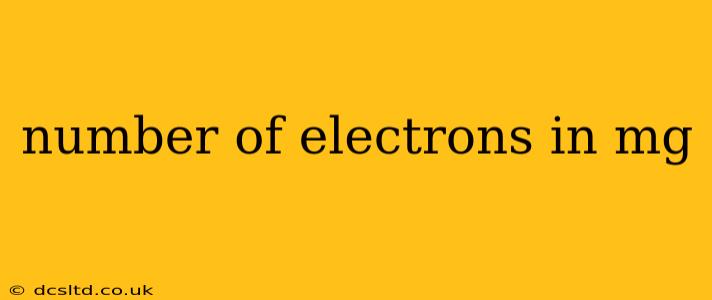Determining the Number of Electrons in Magnesium (Mg)
Magnesium (Mg) is a fascinating element with several practical applications. Understanding its electron configuration is key to comprehending its chemical behavior and properties. This article will delve into the methods of determining the number of electrons in a magnesium atom, addressing common questions along the way.
What is the Atomic Number of Magnesium?
The atomic number of an element dictates the number of protons in its nucleus. Crucially, in a neutral atom, the number of protons equals the number of electrons. Magnesium's atomic number is 12. Therefore, a neutral magnesium atom has 12 electrons.
How Many Electrons Are in Each Shell of Magnesium?
Electrons are arranged in energy levels or shells around the nucleus. The first shell can hold a maximum of two electrons, the second shell eight, and so on. Magnesium's electron configuration follows this pattern:
- 1s² 2s² 2p⁶ 3s²
This means:
- Shell 1 (1s): 2 electrons
- Shell 2 (2s and 2p): 8 electrons
- Shell 3 (3s): 2 electrons
This configuration explains magnesium's chemical reactivity. The two electrons in the outermost shell (valence electrons) are relatively easily lost, leading to the formation of Mg²⁺ ions.
What is the Electron Configuration of Magnesium?
As mentioned above, the electron configuration of magnesium is 1s² 2s² 2p⁶ 3s². This notation describes the arrangement of electrons in the different subshells within the energy levels. Understanding electron configuration is fundamental to predicting the chemical properties of an element.
How Many Valence Electrons Does Magnesium Have?
Valence electrons are the electrons in the outermost shell of an atom and are crucial for determining an element's bonding behavior. Magnesium has two valence electrons in its 3s orbital. These electrons are readily involved in chemical reactions.
Does the Number of Electrons Change in Ions?
The number of electrons does change when an atom forms an ion. Magnesium readily loses its two valence electrons to achieve a stable octet configuration, forming a Mg²⁺ ion. This ion then has 10 electrons.
How to Find the Number of Electrons in Any Element?
To find the number of electrons in any neutral atom, simply look up its atomic number on the periodic table. This number represents the number of protons and, consequently, the number of electrons in a neutral atom. Remember that the number of electrons can change when an atom becomes an ion.
This comprehensive guide clarifies how to determine the number of electrons in magnesium and provides a broader understanding of electron configuration and its implications for an element's chemical properties. Understanding these concepts is fundamental to chemistry and related scientific fields.
